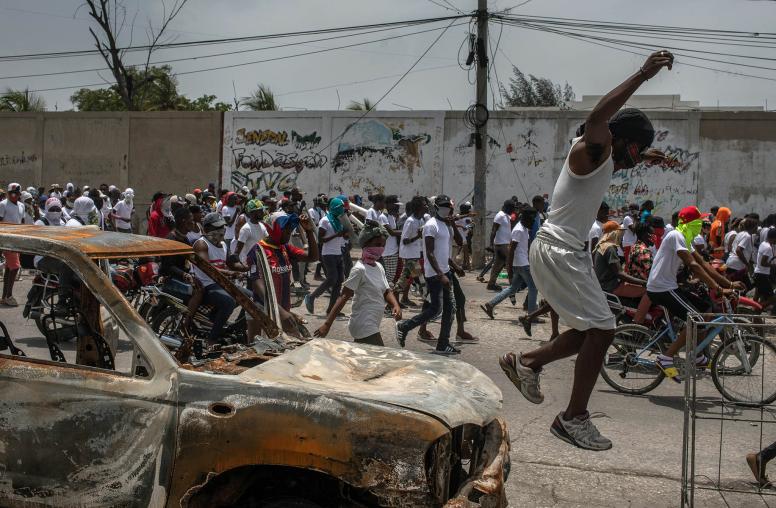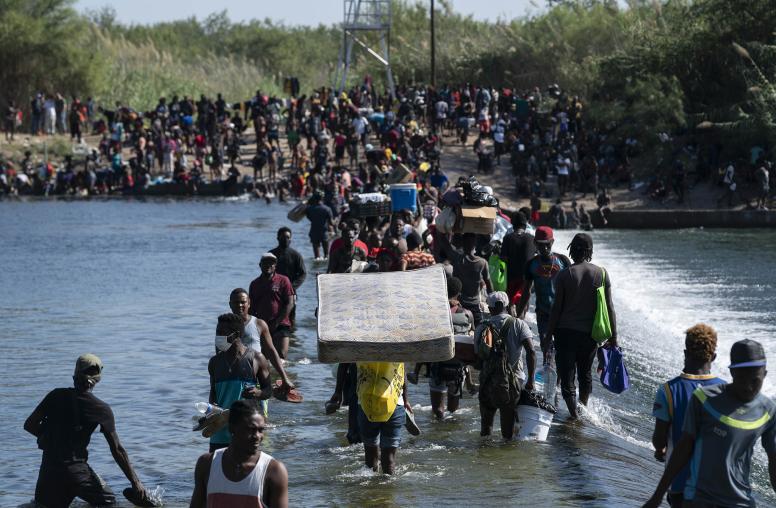'Haiti is Freedom,' My Friend Told Me. That Was News To Me.
Despite common perceptions of Haiti as a place of chaos, violence, and crime, a movement called konbit is looking to spur community-driven change.

“Haiti is freedom” was my friend Sabina’s answer, when I asked her why she loves it there. We were walking under palm trees, returning from a festival organized by a youth center in the coastal city of Jacmel.
Sabina, originally from New Jersey, now lives in Haiti working on an initiative to identify successes in locally-driven development around the country. Her husband Robi, who grew up in the capital Port-au-Prince, is working to nurture a sense of community cooperation through a distinctly Haitian system called konbit that I’ll explain later.
As I listened to Sabina, it was hard to believe that less than a week earlier I was seeing icy rain outside the windows at USIP in Washington, where a panel discussion was underway with experts on Haiti’s future. The room was crowded with interested people despite the foreboding weather.
The panel discussion, titled “Can Elections Save Haiti?” considered the long-delayed senate and local balloting and concluded with a nod to the French expression, “plus ça change, plus c’est la même chose” — “The more things change, the more they stay the same.” Panelist Robert Maguire, director of Latin American and Hemispheric Studies at George Washington University said, “Somehow I feel that we have said these things many times before.”
He was referring to a frustrating impasse: Despite the international community’s willingness to invest in Haiti’s development – 60 percent of the country’s economy comes from foreign aid, the effect always seems to fall far short of expectations. One reason, he said, is the failure of many aid programs to heed the expressed needs and suggestions of Haitians. Maguire cited a document from a 2010 donors conference called “A Voice for the Voiceless” that outlines recommendations from local organizations in Haiti but is rarely heeded by outsiders wishing to help.
Panelist Jonathan Katz, author of the book ”The Big Truck That Went By: How the World Came to Save Haiti and Left Behind a Disaster,” articulated the problem of corruption plaguing Haiti as one rooted in a “zero-sum political culture which prefers the destruction of the enemy over any form of compromise.” Still, he said, it will be the people of Haiti who are in the best position to “save” Haiti.
During my visit to Haiti this month for the first time, it became clear to me that Haitians are more than aware of the government’s failures. They know that money is being pumped into their country, and that it goes missing or is poorly distributed, so that poverty has become systematic and omnipresent.
Before I went to Haiti, I had heard plenty about corruption, violence, and chaotic government services, where they existed at all. What I didn’t hear about was the resilience and determination for change that I saw while I was there.
In stark contrast to the pale picture of disaster most often painted of Haiti stand Sabina and Robi. Sabina’s declaration that “Haiti is freedom” was based not only on its heritage as the first French colony to free itself from colonial rule, but also on its abundant natural resources and its strong and resilient people. Sabina sees Haiti as a place of endless possibilities and almost no rules.
Robi, who was raised in the capital’s well-known slum of Cite Soleil, expresses tremendous pride in his people and their power. He told me about a traditional Haitian system called konbit, a form of communal production whereby a group of people dedicate themselves to cooperation toward a common goal. The tradition is rooted in small agricultural communities throughout Haiti where residents collectively share resources and produce.
Robi is part of a movement trying to spread the heritage of konbit to more urban areas to combat the “zero-sum” culture of personal gain. As he explains it, the concept is like saying, “I believe in you, you believe in me, and we make something together. It’s about choice, it’s about trust. Money can’t change anything. “
In one community I visited, konbit was initiated by a group of young Haitians who moved out of the city to escape urban violence and returned to the mountains where they were raised. They began to learn about and implement sustainable agricultural and building practices despite objections from parents who had worked hard to elevate their children to what they thought would be a higher standard of living in cities.
Examples of the idea also include a community bakery in the capital Port-au-Prince; a social services konbit for the rehabilitation of Cite Soleil; or the Kita Nago movement, in which an ancient tree trunk, like the Olympic torch, was carried on foot 700 kilometers (about 435 miles) from one side of the country to the other in a campaign to demonstrate unity and belief in a common goal.
More specifically, Robi has a vision of applying konbit to rebuild the National Palace in Port-au-Prince that was destroyed during the earthquake of January 2010 and still lies in ruins three years later. Robi’s vision is for Haitians from everywhere to contribute small amounts so that the people gain ownership of the institution as a symbol of strength and change and to jump-start a culture of community and collective effort.
What factors do you think will be most critical in supporting Haitians striving for progress? Tell us your thoughts by submitting a comment below.
Amanda Munroe is distance learning project coordinator in USIP’s Academy for International Conflict Management and Peacebuilding. She is in Haiti following up with students in the Future Generations Graduate School, a USIP partner in developing a master’s degree program in Applied Community Change with a Concentration in Peacebuilding. Robi and Sabina are students in the program.

